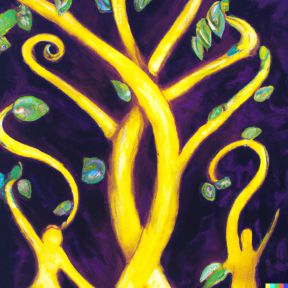
Synchronicity
Synchronicity is a phenomenon in which people interpret two separate—and seemingly unrelated—experiences as being meaningfully intertwined, even though there is no evidence that one led to the other or that the two events are linked in any other causal way. Though many people perceive signs or spiritual meaning in synchronistic events, most scientists believe that such events are more likely coincidences that only seem meaningful due to aspects of human thinking such as confirmation bias.

The concept of synchronicity was developed by psychiatrist and psychoanalyst Carl Jung in the early 1900s. Jung himself believed in synchronicity, which he defined as “meaningful coincidences." He wrote extensively about the concept.
However, most scientists today consider the idea that coincidences are meaningful to be non-scientific. Instead, many argue that factors such as confirmation bias offer a more compelling explanation: People seek out information to support their ideas and ignore information that challenges them.
Synchronicity may be as simple as seeing a word repeatedly and looking for meaning in that experience. In a more complex example, imagine that someone has a dream about an old friend; shortly after, he runs into her. He may believe the events signify something about the friendship, while in reality, they are likely coincidental.
Synchronicity was first defined by Carl Jung in the 1920s and explored throughout his career. It has been subsequently studied by physicists such as Wolfgang Pauli, parapsychologists, and some psychoanalysts and Jungian scholars.
Many modern researchers regard the study of synchronicity as pseudoscience. Synchronistic events can occur randomly, and it may be impossible to scientifically test whether they are, in fact, connected in some meaningful way. What’s more, many instances of synchronicity can be better explained by modern psychological concepts, such as confirmation bias or hindsight bias.
Coincidence and synchronicity are related but distinct terms. The term “coincidence” describes a seemingly related series of events that occur without apparent cause. The term “synchronicity” requires that the individual ascribe deeper meaning to the coincidence; indeed, Carl Jung described synchronicity as “meaningful coincidences.”
In general, yes—particularly because human brains can find “coincidences” in almost anything. Though it’s often not possible to test how likely a particular coincidence is, certain coincidences—like meeting someone with the same birthday—have a measurable probability. A statistical adage known as The Law of Very Large Numbers suggests that in a big enough sample, any so-called “coincidence” is likely to occur.

It can be easy to spot patterns that don’t truly exist. Why are people so susceptible to this tendency? Experts theorize that, from an evolutionary perspective, pattern recognition was likely beneficial for survival: Ancient human ancestors learned to predict possible threats. For instance, they might realize that predators appear at a particular time of day, so it’s safest to stay hidden.
Humans impose structure and meaning on their lives. If they come across two events that seem related, they might categorize them together, even if there’s no objective relationship between the two.
The human brain is designed to identify patterns. While this tendency can be useful, it may lead someone to over-interpret a random occurrence or perceive a pattern where none exists. Individuals vary in their tendency to recognize patterns; those who ascribe greater significance to patterns may be more likely to notice them.
Feeling that one is seeing the same word or number in multiple places could be the result of confirmation or hindsight bias. Although different words and numbers have different probabilities of appearing—meaning that some repeated sightings are statistically less likely than others—ascribing meaning to such coincidences is an example of synchronicity.
Excellent visual or logical pattern recognition skills are strongly correlated with high cognitive ability. For this reason, test of pattern recognition are included in most IQ tests. However, excessive pattern recognition—seeing patterns where none actually exist—may be an indicator of certain mental health conditions, such as psychosis.
Spiritual individuals may interpret coincidences as signs from God or the universe. However, there is no way to scientifically test these beliefs. While seeing coincidences as signs can provide a sense of purpose, following them too closely can lead to ignoring critical evidence. It’s best to weigh common sense, intuition, and verifiable facts when interpreting coincidences.














